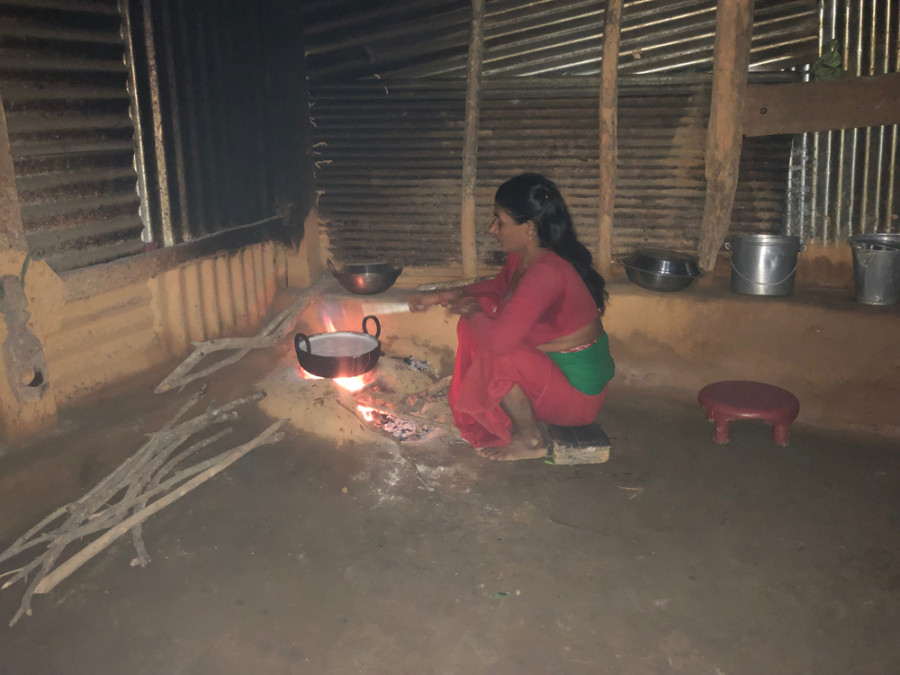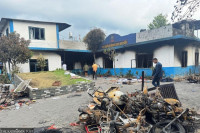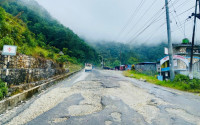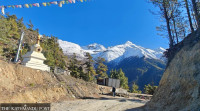Gandaki Province
Prolonged exposure to indoor pollution leads to a rise in asthma cases, mostly in women
With the ‘improved cookstoves’ campaign hitting a snag and no sustainable measures of energy use in sight, more women in Syangja are suffering from respiratory diseases.
Pratiksha Kafle
Seventy-year-old Shanti Lamsal has been cooking food for her family for as long as she remembers. The indoor pollution she has been exposed to over the years became the cause of her asthma. After she was diagnosed with the disease about a decade ago, doctors prescribed her medicines. “Whenever I take the medicine, the disease seems to subside,” said Lamsal. “But once the medicine runs out, the disease grips again, and I can’t wake up and walk.”
Lamsal lives in a village near Biruwa, a valley about 20 kilometres uphill from the district headquarters, Syangja Bazaar. The valley was connected to the road network at the beginning of this decade, but the road is yet to be blacktopped.
There are some signs of modernity coming into the village, with lahures and youths in foreign employment ferrying in TVs and fridges on pick-up trucks. But for the elderly like Lamsal, the way of life has hardly changed.
She laments her compulsion to cook food in the smoke-heavy traditional fireplace that emits smoke enough to cloud the whole house.
The Pokhara-Butwal Siddhartha Highway that cuts through Syangja was built in 1971. Today, a majority of villages in the district are connected to the road network. But due to rough terrain and snaky roads, it’s hard for many like Lamsal in the village to get speedy access to medical care.
Their sons and grandsons might have been in foreign employment, but many like Lamsal can’t let go of the old ways. They still go to the jungles to ferry fodder for cattle and firewood to cook.
“I’m sure it’s the regular work by the fireplace that’s behind my asthma,” said Purna Kumari Khatri, 80, from Bhirkot-3.
Shanti and Purna Kumari are two among the hundreds of women who suffer from asthma caused primarily by continuous exposure to smoke.
This year, a total of 673 new patients, including 432 women, of asthma were referred to the district hospital, according to Buddhisagar Adhikari, medical supervisor at the hospital. Last year, 764 patients were diagnosed, while in 2017, the number was 657.
“While the number of men has been decreasing, that of women patients is on the rise,” said Adhikari. “The reason is clear: exposure to smoke emitted from firewood and smoking.”
Asthma is a chronic breathing disorder caused by exposure to smoke, dust mites and chemical irritants.
Various studies suggest alarming health impacts of indoor air pollution. Nearly 7,500 Nepalis die annually from different diseases linked to indoor air pollution, like acute lower respiratory infection, chronic obstructive pulmonary disease, lung cancer (mainly due to coal), pulmonary tuberculosis, asthma and several cardiovascular disorders.
According to the Wolrd Health Organisation estimates, a total of 235 millions of people suffer from the disease around the world. According to the Global Asthma Report 2018, globally, about 1,000 people die from asthma daily. Asthma is a non-communicable disease and there’s no cure known yet.
Asthma can affect people of all groups and, in Syangja, the number of children suffering from asthma is also on the rise, said Dr Amrit Pokharel, a paediatrician and former chief of the district hospital.
“Many children suffer from the disease due to prolonged exposure to smoke,” said Pokharel. “Further, there’s a trend to oil-massage newly-born children beside the fireplace, which is also one of the reasons behind asthma in children.”
The Biomass Energy Strategy (2017), which mentions that nearly 77 percent of the country’s energy is supplied by traditional biomass energy, has envisioned making the country air pollution-free by 2022 through the promotion of clean cooking technologies.
However, the country’s dependence on traditional biomass energy and fossil fuels has continued as ever.
In Syangja, many villages still rely on traditional fireplaces to cook food. “As usual, it’s the women who are tasked with cooking daily, so it’s no surprise that they get affected with respiratory diseases the most,” said Mitra Prasad Aryal, an officer at the District Health Office, Syangja.
Adhikari, the supervisor, said that studying the various age-groups and data, his office has concluded women who cook at traditional fireplaces are the most vulnerable to asthma.
Yam Prasad Sharma, a public health officer at DHO, said that most of the women suffering from asthma are above 35 years of age.
“Bio-gas and LPG gas are yet to be used in many villages across the district and the drive to replace traditional fireplaces with ‘improved cooking stoves’ (sudhariyeko chulo) has not been a success,” said Dirganarayan Sharma, a local leader.
The ‘improved cookstoves’ campaign was introduced in the district in 2002, spearheaded by the Western Nepal Rural Drinking Water and Cleanliness Project, and ran until 2016.
Most of those fireplaces were destroyed by the 2015 earthquakes. The houses are being reconstructed or renovated but the fireplaces are not, said Dob Bahadur Karki, district chair of the Hariyo Ban Programme.
“The practice of improved cookstoves has almost disappeared,” Karki said. “The lifespan of such stoves is just four years and once they fail to work, nobody builds them again.”
According to 2011 census, only 100 households—out of 68,000 in the district— were using the improved ovens.
Moreover, the local government has failed to take measures to encourage the use of alternative sources of energy.
Rudra Bahadur Malla, chief administrative officer of Putalibazaar Municipality, said that no budget has been allocated for alternative energy this fiscal year.
The current status of energy consumption in rural areas, like in Syangja villages, also results in a gender-energy divide.
Women have to spend hours collecting firewood, the time they could have utilised in other productive works, say experts. On top of that, this is a double whammy for women—they spend energy and time to collect and supply energy sources and they are the ones who suffer health implications due to exposure to air pollution.
Aryal, the officer at DHO, said that the cases of asthma will continue to rise until the villagers are given an option to the traditional fireplaces.
“Not just asthma, prolonged exposure to smoke has also given rise to pneumonia and lung-related diseases,” Aryal said. “This will continue until sustainable energy measures come in widespread practice.”




 8.12°C Kathmandu
8.12°C Kathmandu.jpg)








%20(1).jpg&w=300&height=200)

